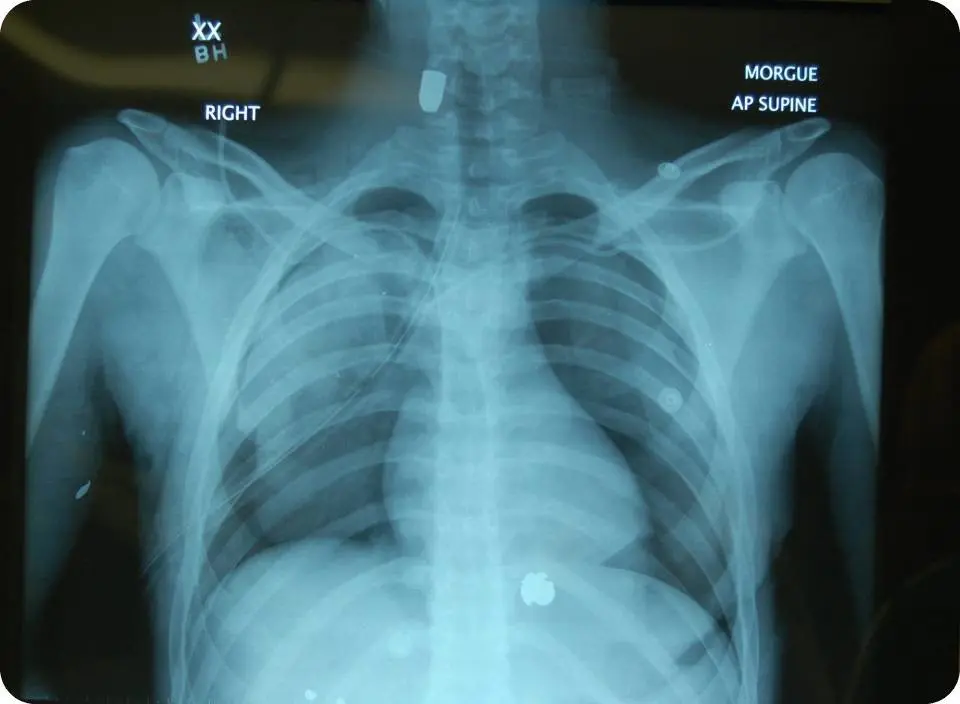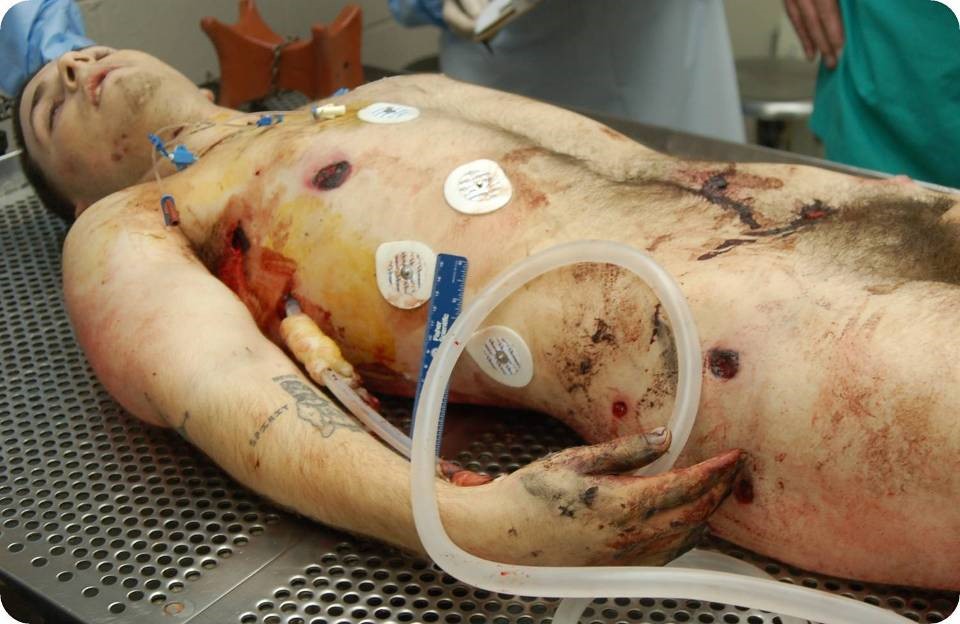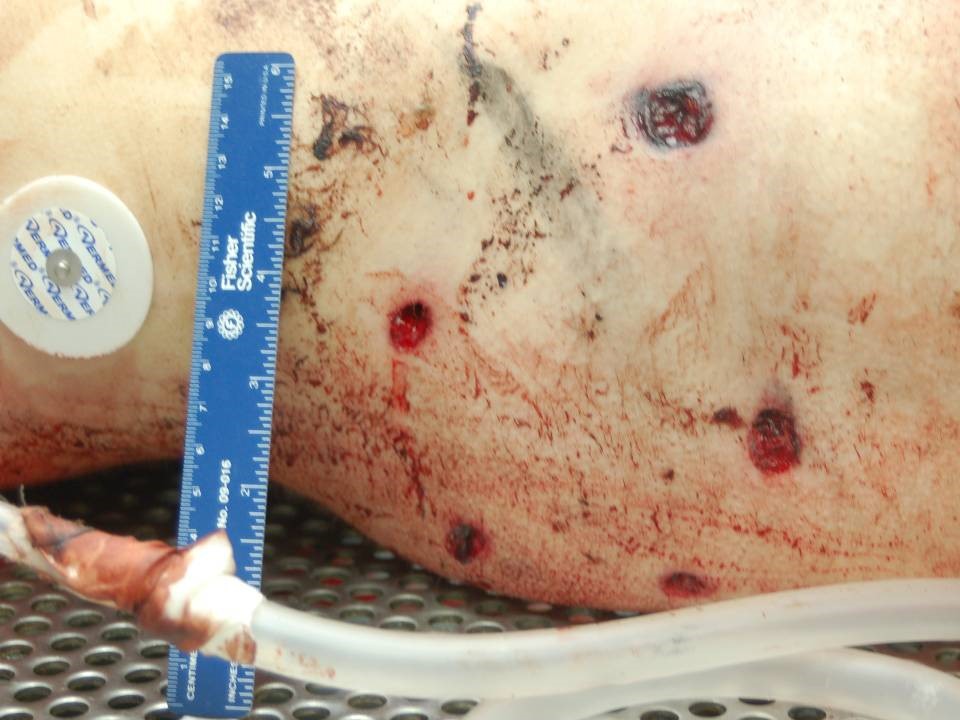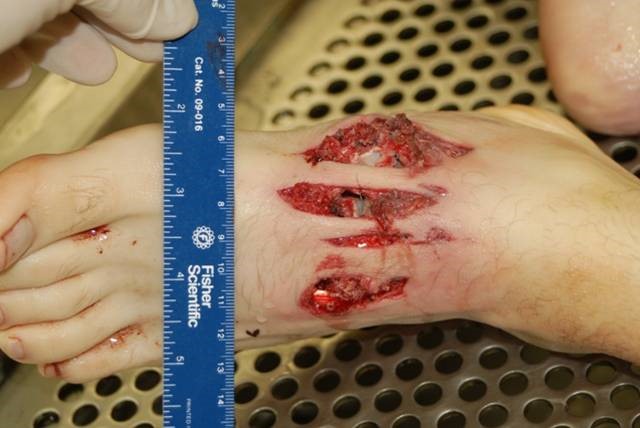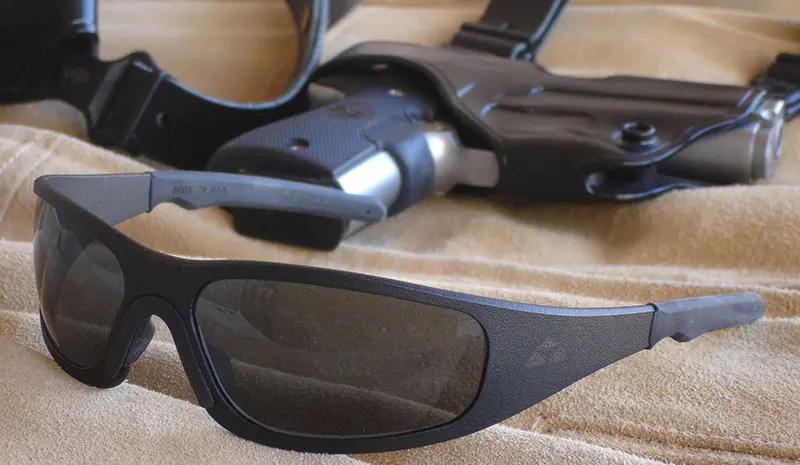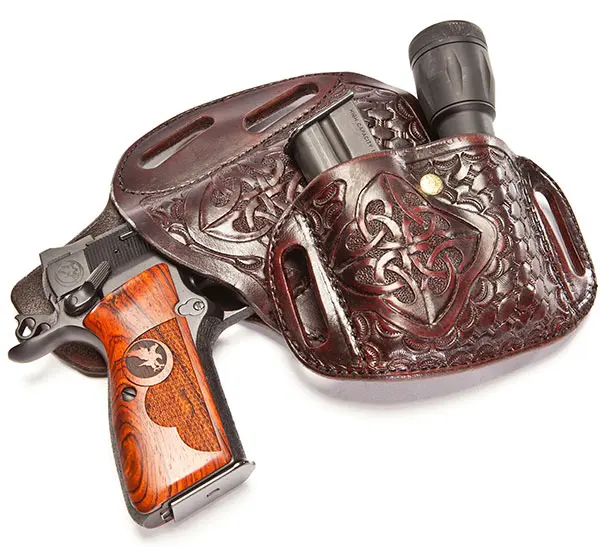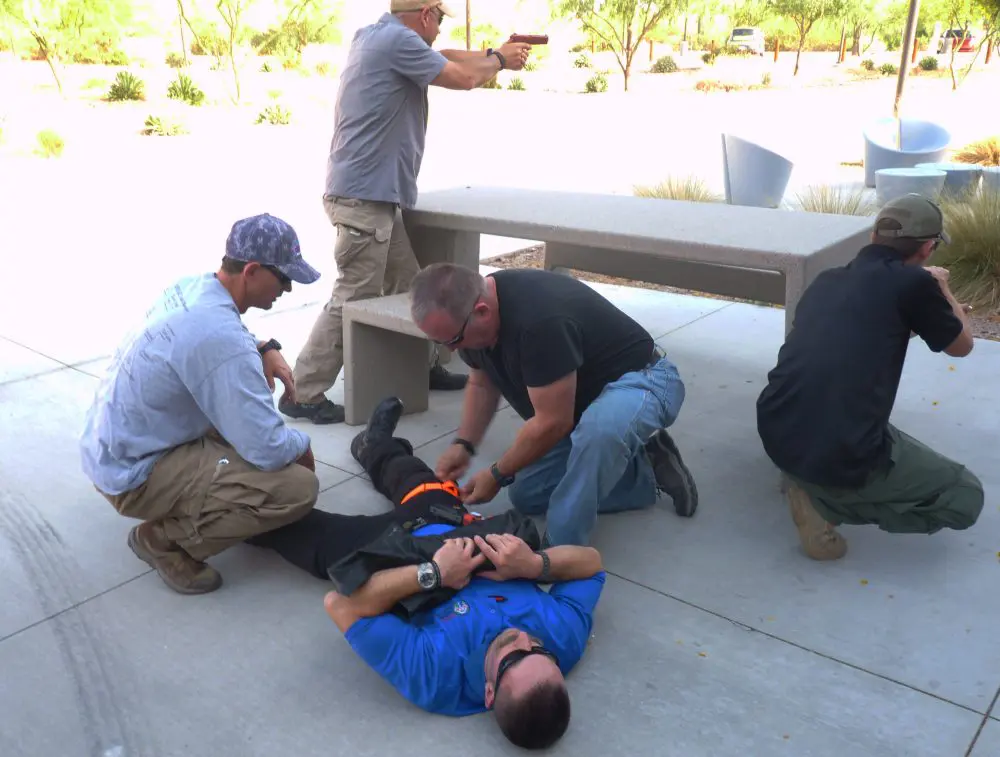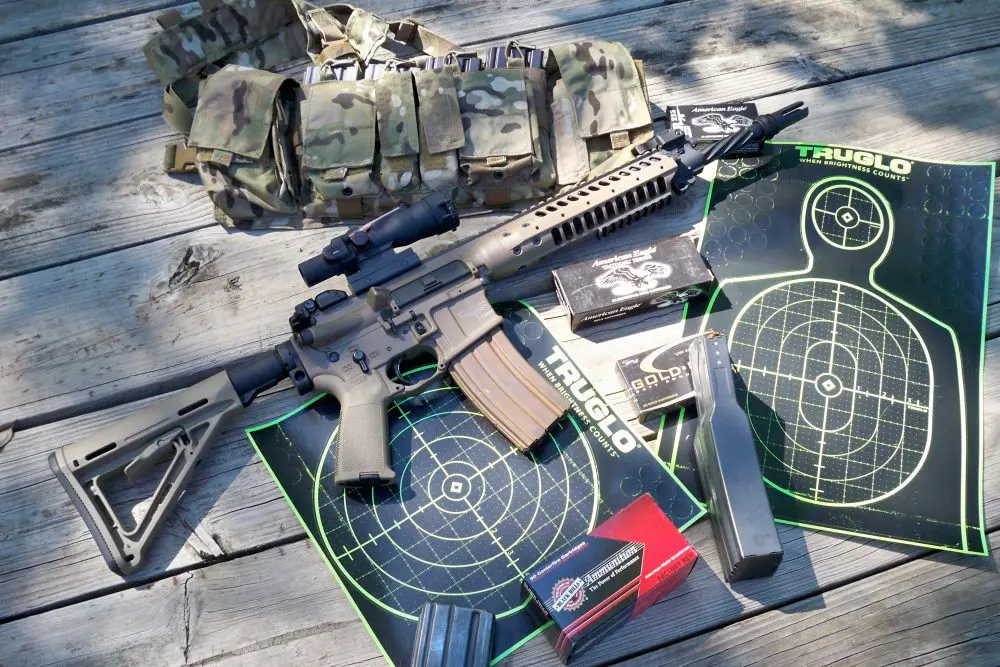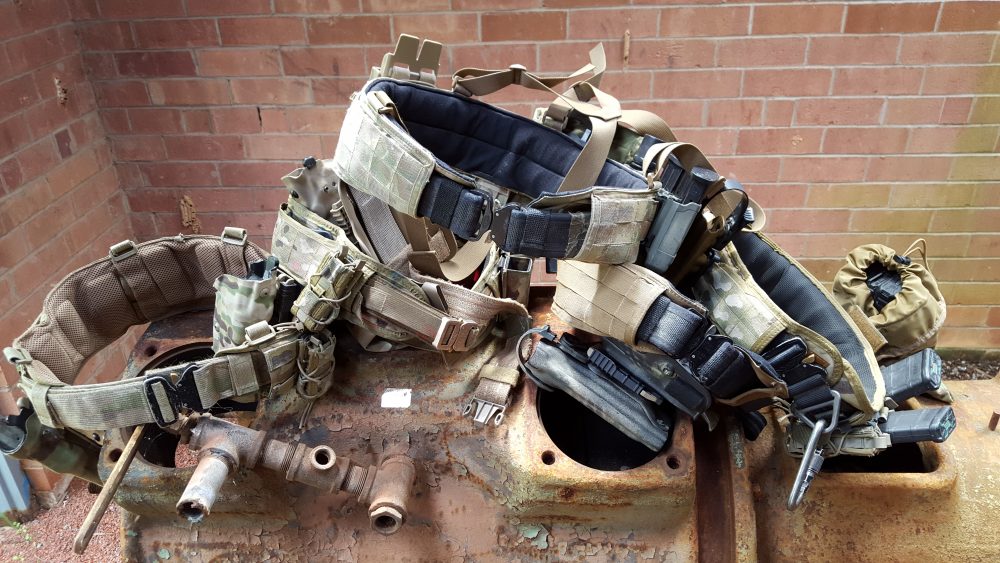[Editor’s Note: The graphic photos accompanying this article are not shown for gratuitous or sensationalistic purposes, but rather to validate the fact that numerous shots may be needed against a determined adversary.]
The term “One Shot, One Kill” became a semi motto in the sniper community sometime in the early 1970s. The term was used to describe the epitome of that profession —a single shot resulting in the instant incapacitation of a threat.
The best example of this is the classic hostage scenario, where a bad guy exits a location, arm around the hostage’s neck and a gun to the hostage’s head. A surgical shot is all that is available, and that shot must be surgically delivered to the perp’s brain, rendering him DRT (Dead Right There).
This central nervous system shot will probably cause the immediate cessation of motor function (to include pressing the trigger of his gun), preventing harm to the hostage and causing the hostage taker to be incapable of any further action. The goal—at least in the police context—does not necessarily mean he will kill the bad guy, just that he will prevent him from taking any further criminal action.
This bad guy received multiple effective hits to the chest and throat but continued to fight.
So far, so good. But not every sniper shot is to the brain. Distance, wind, and movement by the target may indicate a body shot due to the larger target area. This may result in a miss, but even if a hit, it may not be fatal.
Let’s be real here. There is nothing that you can hold in your two hands that can guarantee a kill with a single shot. Nothing. For the average person, regardless of job title, precision shots are seldom a necessity, yet those who do not understand reality chant the mantra at every opportunity.
A variation on the theme was the One Shot Stop, which apparently came about as a way to predict which caliber/bullet would instantly incapacitate a human being. I’m sure that intentions were good, but it failed to include the actions of the shootee. More about that later.
Table of Contents
UNREALITY TV
There are those who watch every movie, video and TV show in which people shoot each other once, causing the shootee to fly backwards, do a 1 1/2 gainer, catch fire and otherwise stop fighting. In more recent movies, the hero has an unlimited supply of ammunition, whose impact makes sparks on anything it hits, including glass, but never leaves a hole—and manages never to hit anyone unintended.
An alternate movie death—especially in old-time movies—is when the bad guy is hit and slowly, very slowly, twists and makes a slow, theatrical, noiseless and bloodless transit into the netherworld. These people marvel at the idea that anyone can miss with one or more shots fired in an incident.
Multiple hits to the pelvis had little effect as well.
I mean, after all, if they have ever fired a gun, they saw how easy it was to hit a piece of paper/can/bottle when they shot at a range, in clear skies and normal temps when there is zero pressure to perform. This is picked up by others as a fact, when it is anything but.
The use of Deadly Physical Force (DPF) should not be taken lightly. While definitions vary according to state, generally speaking DPF can be used to stop someone from using or attempting to use DPF or Physical Force Equating to Serious Physical Injury against you or a third person.
THE SHOOTER
There are two major components at work here—the Shooter and the Shootee. The Shooter component is comprised of multiple layers, including competence, confidence, and knowledge of the law. The Shooter must be proficient in the use of the weapon he is using. He must be confident of his skill in the use of that weapon. And he must be knowledgeable in (CONUS) Use of Force or (OCONUS) Rules of Engagement.
Competence is derived from training, but this is where we (all of us) fall short. Initial training is almost always conducted on the square range, as the facilities are unsophisticated and very basic weapons training can be accomplished there.
On a square range, all shooters stand in a line. The targets are all in a line as well. The instructor tells you how to do everything: when to shoot, what to shoot, where to shoot, when to stop. And no matter where you shoot the targets, they remain stationary, unimpressed by your prowess.
One cop fired from underneath a car into the perp’s foot. Remember that in a gunfight, the bad guy will be moving, which limits your ability to deliver solid hits and limits your available target area. You have to be prepared to shoot the center mass of what is available.
Unfortunately, the greater majority of training continues at the square range, if in fact there is any further training. Once or twice a year, folks gather and shoot a requal. If they fail to qualify, they are remediated and shoot it again. Those in certain units may receive more training, and in some cases it is significantly more.
And for the majority of civilian gun owners, there is little if any initial training and no sustainment training at all. Without training, your ability to hit a piece of paper on a square range is diminished. And generally speaking, delivering shots to an inanimate target is easy stuff. Paper does not move. Ever. It doesn’t move if you shoot it or shoot at it. It just stands there and mocks you.
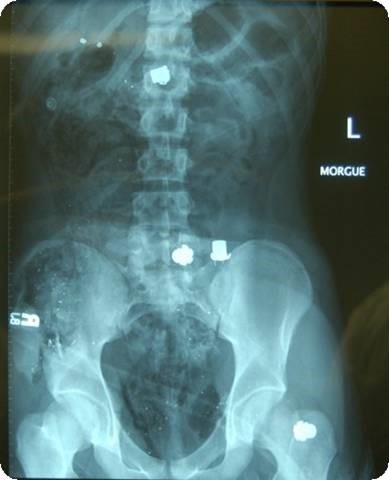
THE SHOOTEE
And herein lies the big issue. People ain’t paper, and no matter who you are, what you have done, or what you know, the bad guy has a vote in the outcome. He decides when the fight starts, and he has the deciding vote when it ends. More importantly he, like you, is flesh and blood. He moves, thinks and functions. And he is trying to kill you.
He may or may not be moving, and that movement may be small or great, but he is not likely to be standing still while he is on the end of your gun. And because he is moving, it will often be difficult for you to surgically place shots into him. The following are a few reasons why your opponent does not react the way people do on the big screen.
- You missed. I know, you never miss on the square range, but consider that maybe 20% of shots fired in a gunfight strike the target. All the rest are in fact misses.
- He is wearing armor. Rifle armor may be visually apparent. Soft armor may not. I have seen pistol bullets defeated by shirt buttons, pens, wallets, belt buckles and more.
- You didn’t hit anything viable. Yup. Your hit may just not be solid. Not all gunshot wounds are fatal or even serious.
- He has not yet realized that he has been shot. This is more common than you may think. While insulting your body with a projectile should hurt—and therefore react in some way—some will not feel that pain immediately. Some people will only go down if you break something. Anyone who has fought with an emotionally disturbed person (EDP) will understand that pain compliance cannot be relied on when your opponent is feeling no pain.
- He is on drugs. He has so much white powder up his nose that his central nervous system is depressed. Again, he feels no pain.
- He is an EDP. He is living in a parallel universe. He is not working on your time or in your world. You think a normal, average earth person would react a certain way, but an EDP is neither average nor normal.
- He is a hard guy. You have Wild Bill Hickock at the other end of your barrel. He is in it to win it. He possesses a sense of purpose that transcends your ability to comprehend.
- He is a true believer. Regardless of his convictions, his dying is not as important as killing you and making a statement are. He hates you, your family, and your way of life. He has no problem dying—he just wants you to die.
- He has nothing to lose. Perhaps the most dangerous of all. Maybe his wife and young children were recently killed in an accident. Maybe he has been diagnosed with a terminal illness. Whatever the reason, he feels he has nothing to live for and doesn’t care if he takes you with
him.
Of the 17 hits, only six remained in the body. If you believe in One Shot, One Kill, you need to adjust your meds.
THE SOLUTION
Notice that the socialists and other know-nothings have jumped on the One Shot, One Kill bandwagon, whereby they believe that anything more than one hit is murder or excessive force.
During a recent highly publicized shooting, a former Chief Medical Examiner stated that the perpetrator was shot six times, and “that is five shots too many.” A former Commanding Officer of the NYPD Firearms and Tactics Section (who hated guns and didn’t believe a cop should be armed off duty) stated in a deposition on magazine capacity that it takes only one well-placed shot to incapacitate a threat.
I am going to quote Dr. Gary Roberts, who understands and explains this better than I ever will.
“The last 25 years of modern wound ballistic research have demonstrated yet again what historical reports have always indicated—that there are only two valid methods of incapacitation, one based on psychological factors and the other physiological damage. People are often rapidly psychologically incapacitated by minor wounds that are not immediately physiologically incapacitating. Psychological factors are also the reason people can receive severe, even non-survivable wounds and continue functioning for short periods of time. Up to fifty percent of those individuals rapidly incapacitated by bullet wounds are probably incapacitated for psychological rather than physiological reasons. Psychological incapacitation is an extremely erratic, highly variable, and completely unpredictable human response, independent of any inherent characteristics of a particular projectile.”
Something that can—and does—happen is that people may go down even when not struck. There are many reasons for this, but I’ll comment on one that is an extreme case.
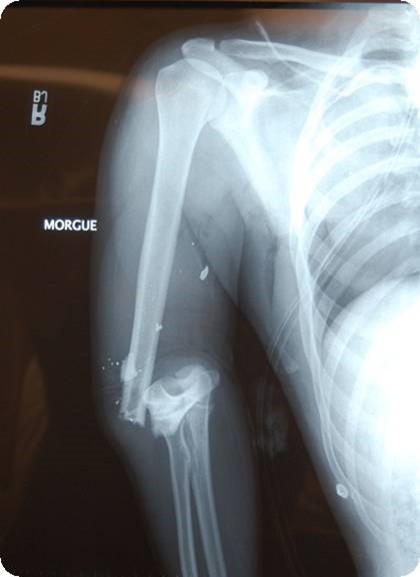
THE NON-EXISTENT HIT
In the mid-1980s, I was sent to the Chapman Academy for two pistol classes. One of the students was a large deputy sheriff. He was a very switched-on guy. Trained a lot. Shot competitively. Read everything he could about police officer survival (I hate that term. I don’t want to survive. I want to win.). He attended multiple courses.
He visualized what may happen in a gunfight. How he would react. He visualized what would happen if he were shot. How would he feel, what would he do? One day he went in early to his off-duty job at a murder burger place. He’d gone to the back to chat with the other workers, when the manager ran in, wide eyed, and shouted, “They’re back!”
Knowing that this manager had been working at another location in the chain and had been held up two times prior, the deputy understood what was happening. The deputy drew his six-inch .44 Special N Frame and brought it up. At the same time one of the mutts, armed with a rifle, came into view, and about seven feet away brought the rifle up and fired. The deputy shot at the same time.
He told me that he felt the bullet hit him in his stomach. It burned as it traversed his body. He fell backward and hit his head on the floor, knocking him unconscious. When he awoke, he understood that there had been a gunfight and he had been shot. He could not remember how many rounds were fired (and few people do), so he dumped his revolver, whipped out his backup Model 24 and sat up. One perp had fled, but the mutt with the rifle was lying on his back, DRT. A female employee ran over to the deputy and asked where he was shot. He held her hand over the painful area and she lifted his shirt up but was unable to find a wound. After a while, he realized that his self-visualization was a bit too strong, and he had talked himself into feeling he’d been shot. Great guy, and it was wonderful that he shared his story. That weekend he went and shot an IPSC match.
People can be bullet sponges and may absorb an enormous amount of damage without becoming incapacitated. In the 1986 FBI Miami gunfight, eight Special Agents attempted to arrest two vicious armed robbers. In the space of a few minutes, two Special Agents were killed and five injured. One perpetrator fired over 42 rounds after receiving a fatal wound—one of 12 before he was incapacitated. And during that time, he killed the two Special Agents and wounded the other five, all after he’d received the fatal wound.
THE ONE-SHOT MYTH
In the day, people actually believed that one shot would cause immediate incapacitation. Unfortunately, many still do. Note that nowhere have I discussed the type of gun, caliber, configuration, ballistic coefficient, weight, or muzzle velocity of the projectile launched from the gun. Nor have I discussed the type or maker of the gun, which gunsmith modified it to make it easier or more efficient to use, or what bloggers have said about it.
The reason for this is simple. Everything named in the above paragraph is a distant second in the overall scheme of things. We are preoccupied with inconsequential minutiae when in fact we should be worried about the final resting place of the cartridges that are in the magazine of your gun right now. Too often people assume that their rational, reasonable thought process about what happens to someone who is shot is the way it will be in reality.
Gunfights are not reasonable. They are dances of death, and the only way you will prevail is to stop him first. One Shot, One Kill is a myth, and its constant repetition does no one any good.
SEVENTEEN HITS
In 2006, three cops from a small east coast agency engaged an armed subject. One cop was shot in the arm at the beginning of the fight. The other two cops received minor injuries. The perp was armed with a .45-caliber pistol. He reloaded his magazine with loose rounds and fired 26 rounds. During the fight, police fired 107 rounds, both .40 S&W and .223. The perp was hit 17 times, 11 of which exited the body. The initial reports, widely disseminated on the Internet, espoused this as a “failure” of .40 S&W, and that the .223 “saved the day.”
In reality, after all .223 rounds were expended, the perp took a .40 S&W in the right arm, breaking it and preventing him from shooting any more. He continued to physically resist the cops when they took him into custody.
The FBI Ballistic Research Facility stated, “A determined individual can sustain many gunshot wounds in areas that produce great pain and continue to fight for a long time even without the aid of drugs or alcohol. Shot placement is everything in a gunfight and is always the key to stopping a threat effectively.”
Pat Rogers is a retired Chief Warrant Officer of Marines and a retired NYPD Sergeant. He is the owner of E.A.G. Inc., which provides services to governmental organizations and private citizens. He can be reached at [email protected].
